Anhydrite, CaSO4, Rhombic, Ccmm
< Specimen No. VI-1 >
Specimen No. VI-1, from the Kano Mine, Fukushima Pref., occurs in a gypsum ore in a Kuroko deposit, and forms an aggregate of thin prismatic crystals associated with an alabasteric aggregate of gypsum. It is pale bluish white in colour.
Barite, BaSO4, Rhombic, Pnma
< Specimens No. VI-—2-No. VI-45 >
Specimens No. VI-2—No. VI-6, from the Motoyama Deposit of the Kosaka Mine, Akita Pref., occur in drusy parts in massive sulphide ores composed of pyrite, galena and sphalerite in a Kuroko deposit. They form tabular crystals with m(210), c(001), d(101), b(010) and o(011), and are colourless and transparent. The largest crystal is 7 cm in diameter.
Specimen No. VI-7, from the Nagaki Mine, Akita Pref., occurs in drusy parts in a quartz vein bearing chalcopyrite and pyrite. The crystals are in a rhombohedral tabular form, white in colour and transparent.
Specimen No. VI-8, from the Edate Mine, Akita Pref., occurs in drusy cavities in a quartz vein bearing pyrite and sphalerite, forms tabular crystals with c(001), m(210) and d(101), and is white in colour and transparent. Scalenohedral crystals of calcite grow on it.
Specimens No. VI-9—No. VI-18, from the Osarizawa Mine, Akita
Pref., occur in drusy cavities in a quartz vein in association with pyrite,
chalcopyrite and sphalerite. The crystals show a tabular form with c(001)
and m(210), accompanied by small faces, d(101), η(310), o(011), b(010)
and z(211). They are white and transparent, and reach 9 cm in diameter (Fig.
83).
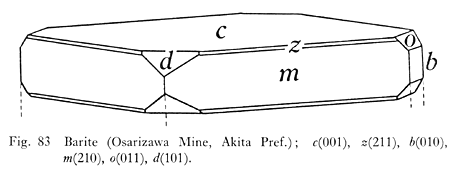
Specimens No. VI-19—No. VI-22, from the Hassei (Tsubaki) Mine, Akita Pref., occur in drusy cavities in massive sulphide ores in a Kuroko deposit. The crystals are parle-yellow to pale yellowish orange in colour, transparent, and tabular in form with c(001), a(100), b(010), o(011), d(101) and m(210), among which a, c and m are prominently developed.
Specimens Nos. VI-23 & VI-24, from the Arakawa Mine, Akita Pref., occur in drusy cavities in a chalcopyrite-quartz vein, and form rosette aggregates of tabular crystals associated with malachite. They are colourless and transparent.
Specimen No. VI-25 from the Komakizawa Mine, Akita Pref., occurs in drusy cavities in a quartz vein bearing chalcopyrite, sphalerite and pyrite, and forms rhombic tabular crystals white and transparent. The crystals reach 12 cm in length.
Specimen No. VI-26, from Kawarage, Akita Pref., occurs as vein mineral in an altered andesite. The crystals form rhombohedra with c(001) and m(210), up to 1 cm in diameter and pale brown to light grey in colour. It is a Pb-bearing (PbO; 3%) variety.
Specimen No. VI-27, from the Okinazawa Mine, Iwate Pref., occurs as a massive aggregate of tabular crystals. In its drusy part, the crystals grow in tabular rhombohedra with the combination of c(001), m(210), (011) and d(101). Their colour is white to pale grey.
Specimen No. VI-28, from the Shichirizawa Mine, Miyagi Pref., occurs in a druse of a quartz vein in an epithermal copper deposit, and forms rhombic tabular crystals with c(001), d(101) and m(210).
Specimens Nos. VI-29 & VI-30, from the Sado Mine, Niigata Pref., occur
in drusy cavities of a quartz vein in an epithermal gold-silver deposit. Specimen
No. VI-29 is pale green, transparent and tabular crystals with c(001), d(101),
m(210) and o(011). Specimen No. VI-30 consists of elongated in the direction
of the brachy axis. Faces observed are d(101), m(210) and o(011). They are
pale green to pale yellow and transparent. The largest crystal is 10 ×
2 × 2 cm in size (Fig. 84).
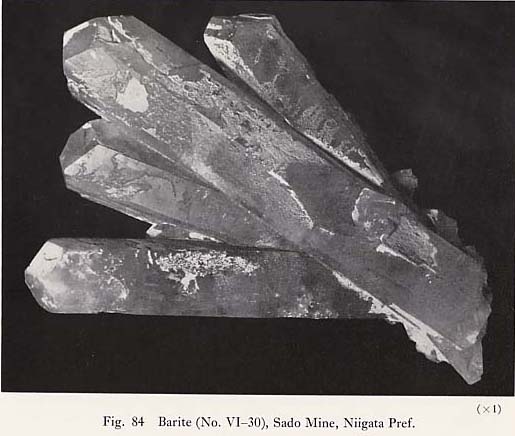
Specimens Nos. VI-31 & VI-32, from Nakayamatoge, Niigata Pref., occur as cementing material in crevices of sandy-clayey nodules in Miocene strata, and as isolated crystals in detrital earth.
Specimen No. VI-33, from the Kuradani Mine, Ishikawa Pref., occurs in drusy cavities in a quartz vein bearing pyrite and chalcopyrite, and forms a rhombohedral crystal 15×30×38 mm in size, grey in colour and transparent to translucent.
Specimens Nos. VI-34 & VI-35, from the Nabeto Mine, Ishikawa Pref., occur on crystalline quartz in an epithermal copper deposit, and form rhombic tabular crystals colourless and transparent.
Specimens No. VI-36-No. VI-38, from the Omodani Mine, Fukui Pref., occur in drusy cavities in a quartz vein bearing pyrite and chalcopyrite, and form tabular crystals up to 1 cm in diameter, grey and transparent. Faces observed on the crystals are the combination of c(001), d(101) and m(210).
Specimens No. VI-39-No. VI-43, from the Changdo Mine, Korea, occur as a vein cutting through a dolomite bed. The crystals show a rhombic form with c(001), m(210) and d(101), and a short prismatic form elongated in the direction of the c-axis. They are white in colour and transparent to translucent.
Specimen No. VI-44, from Santon-sho, China, is a white and translucent massive aggregate.
Specimen No. VI-45, from the Kinkaseki Mine, Formosa, occurs on crystalline quartz surrounding drusy cavities in a quartz vein bearing enargite. The crystals form transparent rhombohedra with c(001) and m(210), and are 5 mm in size on an average.
Hokutolite, (Ba, Pb)SO4, (variety of barite)
< Specimens No. VI-46—No. VI-56 >
Specimens No. VI-46—No. VI-52, from the Tamagawa Hot Spring,
Akita Pref., occur as precipitation mineral from the strongly sulphuric hot
spring, and form incrustations with banded alternation of pale brown parts
and brown parts. The crystals are rhombic plates (Pl. 11).

HOKUTOLITE (No. VI-48) Tamagawa Hot Spring, Akita Pref.
Specimens No. VI-53—No. VI-56, from the Hokuto Hot Spring, Formosa, occur as precipitation product in the hot spring, and form pale brown incrustations around masses of andesitic rock. The crystals are rhombohedra up to a few millimeters in size. Powdery aggregates of jarosite are associated.
Anglesite, PbSO4 , Rhombic, Pnma
< Specimens No. VI-57—No. VI-61 >
Specimens Nos. VI-57 & VI-58, from the Kisamori Mine, Akita Pref., occur as secondary mineral in cavities in an oxidized copper-lead-zinc ore. The crystals form short prisms up to 3 cm in diameter, and are white in colour and translucent. Their main faces are m(210), d(101) and c(001).
Specimen No. VI-59, from the Karatoya Mine, Yamagata Pref., occurs as secondary product in an oxidized ore from an epithermal copper-lead-zinc deposit. The crystals are in octahedra with l(421), and pale brown to grey in colour.
Specimen No. VI-60, from the Ohinata Mine, Nagano Pref., occurs in a fracture of an oxidized ore composed of pyrite, galena and sphalerite. The crystals are in spindle-shaped octahedra with l(421), white and translucent.
Specimen No. VI-61, from the Kubong Mine, Korea, occurs in drusy cavities in a quartz vein bearing galena, and forms prismatic crystals terminated by the pyramidal faces, l(421). They are dark grey and translucent.
Brochantite, Cu4[(OH)6|SO4], Monoclinic, P21/a
< Specimens No. VI-62—No. VI-76 >
Specimens No. VI-62—No. VI-67, from the Arakawa Mine, Akita Pref., occur as secondary mineral in cavities in a chalcopyrite-bearing quartz vein, and form radial aggregates or groups of small acicular crystals bright green and transparent.
Specimens No. VI-68—No. VI-70, from the Kisamori Mine, Akita Pref., occur in cavities in an oxidized copper ore, and form groups of small acicular crystals up to 5 mm in length and bright green in colour. Associated minerals are cerussite, malachite and chrysocolla.
Specimens No. VI-71—No. VI-76, from the Rendaiji Mine, Shizuoka
Pref., occur in cavities in a quartz vein of an epithermal copper deposit,
forming groups of green acicular crystals up to a few millimeters in length.
Associated minerals are azurite and chalcocite as in specimen No. VI-75 (Plate
11).
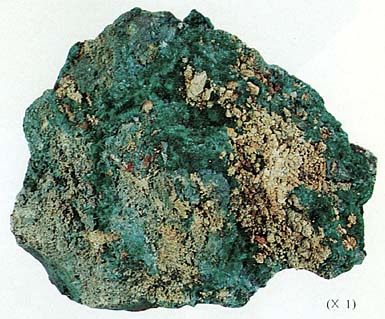
BROCHANTITE (No. VI-71) Rendaiji Mine, Shizuoka Pref.
Linarite, PbC4[(OH)4|(SO4)], Monoclinic, P21/m
< Specimens No. VI-77—No. VI-99 >
Specimen No. VI-77, from the Arakawa Mine, Akita Pref., occurs in fractures and cavities in a chalcopyrite-bearing quartz vein in an oxidized zone, and forms crustal aggregates of small prismatic crystals.
Specimens No. VI-78—No. VI-81, from the Hisaichi Mine, Akita Pref., occur as secondary product in fractures and cavities in a quartz vein bearing chalcopyrite, pyrite and sphalerite, and form crustal aggregates of blue prismatic crystals reaching 1 cm in length. Co-existing secondary minerals are malachite and cerussite.
Specimens No. VI-82—No. VI-98, from the Kisamori Mine, Akita
Pref., occur as secondary mineral in fractures of oxidized ores in an epithermal
cop per-lead-zinc deposit, and form groups or aggregates of small crystals
tabular or prismatic with m(110), b(010), a(100), u(![]() 01)
and s(
01)
and s(![]() 01). They are deep blue
to cobalt blue with glassy lustre, and up to 2 cm in length. Associated secondary
minerals are malachite, cerussite and pyromorphite (Plate 11).
01). They are deep blue
to cobalt blue with glassy lustre, and up to 2 cm in length. Associated secondary
minerals are malachite, cerussite and pyromorphite (Plate 11).
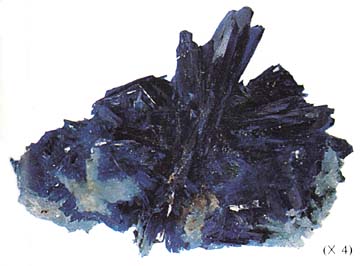
LINARITE (No. VI-89) Kisamori Mine, Akitn Pref.
Specimen No. VI-99, from the Omodani Mine, Fukui Pref., occurs in fractures of an oxidized ore in an epithermal copper-lead-zinc deposit, and forms a blue incrustations on galena crystals. They are radial and spherical aggregates of prismatic crystals.
Natroalunite, NaAl3[(OH)6|(SO4)2], Trigonal, R3m
< Specimens No. VI-100—No. VI-106 >
Specimens No. VI-100—No. VI-104, from the Ugusu Mine, Shizuoka Pref., occur as alteration product in a hydrothermally altered rhyolitic rock. In their drusy cavities, the crystals grow in thin hexagonal tabular or lamellar forms or in rosette aggregates. They are white in colour with yellowish tint.
Specimens Nos. VI-105 & VI-106, from Hetamura, Shizuoka Pref., occur as vein mineral in an andesitic rock in association with sulphur crystals. Alunite forms rosette aggregates of thin hexagonal lamellae up to 1 cm across, white in colour and transparent.
Alunite, KAl3[(OH)6|(SO4)2], Trigonal, R3m
< Specimens No. VI-107—No. VI-112 >
Specimens No. VI-107—No. VI-112, from the Kinkaseki Mine, Formosa, occur as aggregates of hexagonal lamellar crystals filling fractures in an enargite-bearing quartz vein and its country rock. Sometimes, they form rosette aggregates yellowish pale brown in colour.
Gypsum, Ca[SO4]·2H2O, Monoclinic, A2/n
< Specimens No. VI-113—No. VI-133 > (Fig. 85)
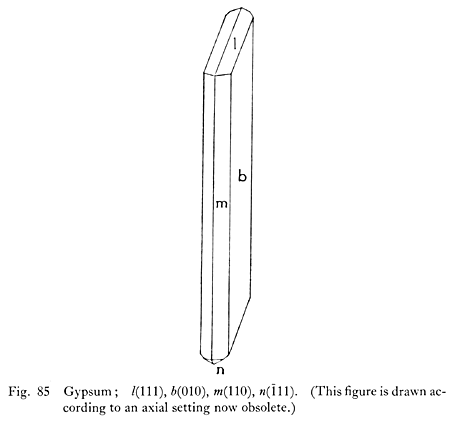
Specimens No. VI-113—No. VI-116, from the Hanaoka Mine, Akita Pref., occur in cavities of massive sulphide ores mainly composed of quartz and pyrite in a Kuroko deposit. They are colourless and transparent, and form slender prismatic crystals up to 30 cm in length.
Specimens No. VI-118—No. VI-121, from the Miyazald Mine, Miyagi Pref., occur as interstratified mineral in tuff, and form aggregates of transparent prismatic crystals. Faces observed are m(110), b(010) and l(111).
Specimen No. VI-122, Akaginemura, Gumma Pref., occurs in clayey strata, and forms platy prismatic crystals reaching 1 cm in length.
Specimens No. VI-123—No. VI-125, from Owakudani, Kanagawa Pref., occur in a solfataras in the craters of an active volcano, and form thin tabular crystals, sometimes their radial aggregates. They are colourless and transparent. Faces observed are m(110), b(010) and l(111).
Specimens Nos. VI-126 & VI-127, from Yogosawa, Yamanashi Pref., occur as isolated crystals from a clay, and form transparent prismatic crystals attaining 2 cm in length.
Specimen No. VI-128, from the Noto Mine, Ishikawa Pref., occurs in clayey strata in a Kuroko deposit, and forms transparent prismatic crystals with m(110), b(010) and l(111). The largest crystal is 10 cm in length.
Specimen No. VI-129, from the Bandojima Mine, Fukui Pref., occurs in a fracture of a sphalerite-bearing quartz vein. It is massive aggregate of prismatic crystals grey in colour and transparent to translucent.
Specimen No. VI-130, from the Kanagase Deposit of the Ikuno Mine, Hyogo Pref., occurs as secondary mineral in a fracture of a chalcopyrite-bearing quartz vein and is associated with a small amount of stannoidite. The crystals are in the form of short prism with l(111), m(110) and b(010), and 3 cm in length on an average.
Specimen No. VI-131, from the Udo Mine, Shimane Pref., occurs as gypsum ore in a Kuroko deposit, and forms transparent slender crystals with m(110), b(010) and l(111). The largest crystal is 10 cm in length.
Specimen No. VI-132, from Barden, Germany, is an isolated crystal in a prism with m(110), b(010) and l(111), and about 3 × 4 × 6 cm in size.
Specimen No. VI-133, from Ohio, U.S.A., is an isolated prismatic crystal 4 cm in length.